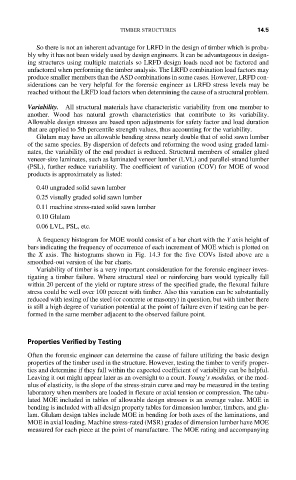Page 514 - Forensic Structural Engineering Handbook
P. 514
TIMBER STRUCTURES 14.5
So there is not an inherent advantage for LRFD in the design of timber which is proba-
bly why it has not been widely used by design engineers. It can be advantageous in design-
ing structures using multiple materials so LRFD design loads need not be factored and
unfactored when performing the timber analysis. The LRFD combination load factors may
produce smaller members than the ASD combinations in some cases. However, LRFD con-
siderations can be very helpful for the forensic engineer as LRFD stress levels may be
reached without the LRFD load factors when determining the cause of a structural problem.
Variability. All structural materials have characteristic variability from one member to
another. Wood has natural growth characteristics that contribute to its variability.
Allowable design stresses are based upon adjustments for safety factor and load duration
that are applied to 5th percentile strength values, thus accounting for the variability.
Glulam may have an allowable bending stress nearly double that of solid sawn lumber
of the same species. By dispersion of defects and reforming the wood using graded lami-
nates, the variability of the end product is reduced. Structural members of smaller glued
veneer-size laminates, such as laminated veneer lumber (LVL) and parallel-strand lumber
(PSL), further reduce variability. The coefficient of variation (COV) for MOE of wood
products is approximately as listed:
0.40 ungraded solid sawn lumber
0.25 visually graded solid sawn lumber
0.11 machine stress-rated solid sawn lumber
0.10 Glulam
0.06 LVL, PSL, etc.
A frequency histogram for MOE would consist of a bar chart with the Y axis height of
bars indicating the frequency of occurrence of each increment of MOE which is plotted on
the X axis. The histograms shown in Fig. 14.3 for the five COVs listed above are a
smoothed-out version of the bar charts.
Variability of timber is a very important consideration for the forensic engineer inves-
tigating a timber failure. Where structural steel or reinforcing bars would typically fall
within 20 percent of the yield or rupture stress of the specified grade, the flexural failure
stress could be well over 100 percent with timber. Also this variation can be substantially
reduced with testing of the steel (or concrete or masonry) in question, but with timber there
is still a high degree of variation potential at the point of failure even if testing can be per-
formed in the same member adjacent to the observed failure point.
Properties Verified by Testing
Often the forensic engineer can determine the cause of failure utilizing the basic design
properties of the timber used in the structure. However, testing the timber to verify proper-
ties and determine if they fall within the expected coefficient of variability can be helpful.
Leaving it out might appear later as an oversight to a court. Young’s modulus, or the mod-
ulus of elasticity, is the slope of the stress-strain curve and may be measured in the testing
laboratory when members are loaded in flexure or axial tension or compression. The tabu-
lated MOE included in tables of allowable design stresses is an average value. MOE in
bending is included with all design property tables for dimension lumber, timbers, and glu-
lam. Glulam design tables include MOE in bending for both axes of the laminations, and
MOE in axial loading. Machine stress-rated (MSR) grades of dimension lumber have MOE
measured for each piece at the point of manufacture. The MOE rating and accompanying

